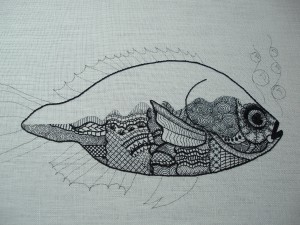Types of Hand Embroidery on Needle ‘n Thread
Blackwork
 |
Traditionally, blackwork was used on clothing. The focus of blackwork is generally the variety of filling patterns used within the elements of the design. Looking at blackwork from the 16th century, a design could include vines, leaves, and flowers stitched with a heavy outline, but the inside of the leaves and flowers would be intricately filled with lacy, usually geometric, patterns.
In earlier centuries, blackwork was worked normally on white or light linen with black thread, but today, it is often seen on dyed fabrics and worked in a variety of colors. Variegated silks are a popular choice for blackwork today.
Blackwork commonly employs a variety of filling patterns worked in Holbein stitch, which looks like backstitch, but is actually reverse running stitch. The design is worked in one direction in running stitch, leaving a stitch space between each stitch. Then, the embroiderer works the design in the opposite direction, filling in the empty spaces with another running stitch.
Modern blackwork is popularly used to create geometric designs, but can also be used to stitch beautiful “picture” embroidery. Various levels of shading can be achieved in blackwork by varying the filling stitches and patterns and the weight of the thread. Modern Blackwork is often effectively combined with counted cross stitch and surface techniques to good effect.
Related posts:






